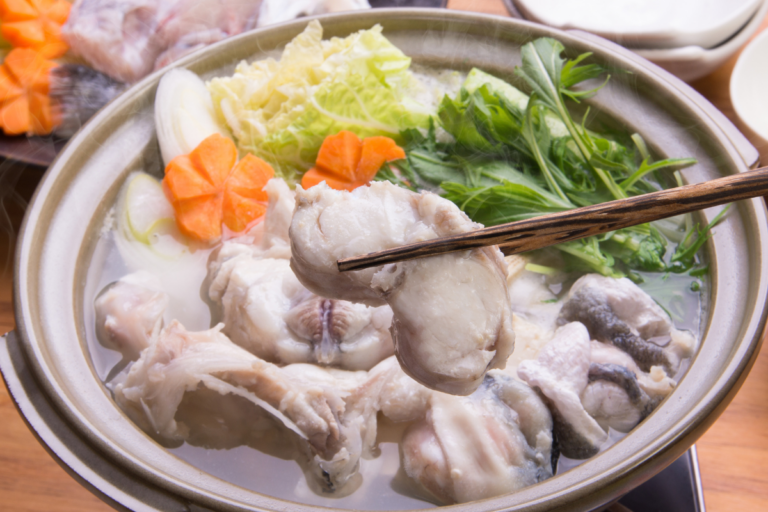Fugu, also known as puffer fish, holds a place, in cuisine as a captivating yet risky delicacy. People celebrate Fugu for its flavor and tender consistency, but they also fear it for its toxicity if mishandled during preparation. This piece explores the history behind this dish, the process of readying it for consumption, and the distinctive elements that elevate this dish to a culinary masterpiece while serving as a true test of a chef’s expertise.
Historical Roots and Evolution
For centuries, fugu has been savored in Japan, with documented accounts tracing it to the Jomon era (10,000 BCE – 300 BCE). Initially savored by samurai warriors and esteemed members of society for its taste. The thrill it brought to dining experiences. People relish fugu throughout Japan today, especially in Shimonoseki in Yamaguchi Prefecture, which is celebrated as Japan’s hub for fugu cuisine.
Ingredients and Cooking Fugu Method
Ingredients:
- Caught fugu (pufferfish)
- Sake (Japanese rice wine)
- Soy sauce
- Mirin (rice wine)
- Ponzu sauce (a soy citrus blend)
- Green onions
- Daikon radish
- Shichimi togarashi (Japanese seven-spice blend)
- Seaweed (for garnish)
Step-by-Step Guide
Acquiring:
Buy fugu from a trusted seller, ensuring it is fresh and handled safely.
Cleaning and Preparing:
A chef should handle this task. The chef delicately removes the skin due to its toxicity.
Remove and discard the organs like the liver, ovaries, and intestines that contain tetrodotoxin.
Fillet the fish without any contact with the parts.
Slicing for Sashimi:
Using a special knife, thinly slices the fugu in an intricate manner called “usuzukuri,” showcasing precision and expertise.
Arrange the slices on a plate in a design symbolizing death in tradition, a subtle acknowledgment of the dish’s peril.
Preparing Accompaniments:
Combine ponzu sauce with daikon radish and scallions.
Offer shichimi togarashi on the side for a burst of flavor.
Presentation:
Serve sashimi with condiments, alongside a sake cup to enhance its flavor.
If you want, you can also try this dishes, like fried fugu (fugu karaage) or fugu hot pot (fugu nabe) to enhance your dining experience.
The Fugu Dining Experience
Enjoying eating, it’s a journey filled with tradition and anticipation. The excitement of the risks paired with the flavors and texture of the fish makes it a delicacy cherished by food enthusiasts around the globe. In Japan, indulging in fugu is a tradition that showcases both the chef’s expertise and the diner’s bravery.
This dish represents the balance between danger and reward in gastronomy. Its meticulous preparation demands. A profound reverence for its ingredients. For those seeking an adventure, it promises a mix of thrill and pleasure. Highlighting the finesse of Japanese culinary heritage.
Interesting Facts About Fugu
Dangerous Delight: Fugu fish contains tetrodotoxin, a neurotoxin that’s 1,200 times more poisonous than cyanide. Even a small dose can be lethal.
Skilled Chefs Only: In Japan, only chefs who have completed training and passed an exam are permitted to prepare and serve fugu.
Historical Prohibition: Fugu was outlawed in Tokyo during the Edo era due to its nature. The ban was lifted in 1888 by Emperor Hirohito, who had a taste for the dish.
Art of Cooking: The art of preparing fugu is highly regarded in Japan, with chefs slicing the fish into thin pieces to showcase their craftsmanship.
Fugu Sashimi: The popular way to enjoy fugu is sashimi, known as “usuzukuri.” The slices are arranged in a design symbolizing mortality.
Fugu Skin: The skin of the fugu fish is also eaten after being lightly boiled. Served with vinegar for added flavor.
Liver Prohibition: Although people once considered liver a delicacy, authorities have now banned serving it in restaurants due to its toxicity.
Luxurious Indulgence: This fish ranks among the dishes in Japan, often commanding a hundred dollars, per serving.
Taste and Texture: People usually enjoy during the months when the fish is at its peak in size and flavor. Known for its taste and firm texture, fugu is a sought-after delicacy for those who appreciate a fine dining experience.
Cultural Significance: People often view partaking in fugu as a symbol of prestige and courage, showcasing the diner’s confidence in the chef’s expertise.
Variety of Preparations: There are ways to savor in pots (fugu nabe) fried (fugu karaage) or grilled (fugu teriyaki).
Another Factor About this Dish
Fugu Festivals: Certain regions in Japan hold festivals that honor the fish through events, contests, and lavish meals.
International Regulations: Although people primarily associate fugu with Japan, they also enjoy it in other countries. Served in countries under stringent guidelines.
Training Duration: Becoming proficient in preparing fugu can take more than ten years for a chef to ensure they can safely eliminate all parts.
Toxin’s Effect: The toxin tetrodotoxin operates by obstructing sodium channels in nerves, leading to paralysis and fatal consequences, like muscle weakness causing suffocation.
Medical Fascination: Although tetrodotoxin is hazardous, researchers have explored its potential, in medicine, such as its use as a pain reliever for individuals with cancer.
What next:
- Crocodile Ice Cream: A Wild Adventure in Dessert-Making
- Pasta Carbonara- A Classic Italian Delight
- Japanese Miso Glazed Salmon – A Delicious Taste and Health
- Feijoada – A Taste of Brazil
- Bouillabaisse – The Legendary Fish Stew, from Marseille


